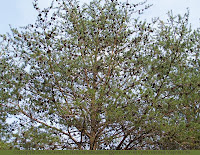Pinus virginiana, scrub pine, Jersey pine, spruce pine

My home, Christian County, Kentucky, is at the extreme western edge of the natural range of Virginia Pine (pinus virginiana).
Here, I see Virginia pines mostly on high, rocky ridges. Usually, the trees are growing at the edges of woods or in small pure stands (Pure stand: A timber stand in which at least 80 percent of the trees in the main crown canopy are of a single species. Source: Forest Stewardship Glossary.)
 Virginia pines are easy to recognize, even from a distance. They are small, dark-colored pines with short needles. Close examination will reveal that the needles are twisted and are borne in bundles of two. Usually, many small pine cones are scattered throughout the branches. The pine cones can stay on the trees for years after they've opened and dropped their seeds.
Virginia pines are easy to recognize, even from a distance. They are small, dark-colored pines with short needles. Close examination will reveal that the needles are twisted and are borne in bundles of two. Usually, many small pine cones are scattered throughout the branches. The pine cones can stay on the trees for years after they've opened and dropped their seeds.Virginia pines typically have many branches coming off their main trunks. A number are nearly always dead, especially at the bottom of the tree. Each of the branches causes a knot in the wood, causing the lumber to be weak and marred.
The Virginia pine is grown commercially as a source of rough lumber and pulpwood and as a favorite Christmas tree.
 The tree has an important role in nature. It is a pioneer species that holds the soil and adds to the humus until the soil is improved enough that other species can move into the area. It grows in rough, dry, rocky areas of thin soil that are too poor for other trees to take root and survive. It often establishes itself in worn-out fields, strip-mined areas, burned-out land, eroded hillsides, and cleared forests.
The tree has an important role in nature. It is a pioneer species that holds the soil and adds to the humus until the soil is improved enough that other species can move into the area. It grows in rough, dry, rocky areas of thin soil that are too poor for other trees to take root and survive. It often establishes itself in worn-out fields, strip-mined areas, burned-out land, eroded hillsides, and cleared forests.The tree absolutely does not tolerate shade. A stand of Virginia pine cannot easily perpetuate itself because the seedlings cannot survive in the shade of the adult trees. Thus, other trees that are more shade tolerant establish themselves in the understory of the Virginia pines and take over as the Virginia pines die.
Virginia pines may reach 60 feet or more in height, but are often smaller, depending on growing conditions. Old Virginia pines are a favorite nesting place for woodpeckers because they often have rotten wood that is easy to excavate.
Virginia pine is not often grown as a garden tree because of its "scrubby" appearance. It is often lopsided, and as already noted, it nearly always has dead branches that have not dropped. An abundance of prickly pine cones may be a nuisance. The shallow roots that enable it to survive in areas of thin soil also make it vulnerable to being tipped over in high winds. The soft-wooded branches frequently break in weather events.
Still, Pinus virginiana is a tree to consider when the terrain is so inhospitable that other trees don't survive. If planted in thickets, the group will help support individuals in the wind. It needs an acidic to neutral soil pH. It is a slow-growing tree that might achieve 25 feet in its first 20 years under good conditions. It rarely lives to be a century in age.
More information:
Virginia Pine (U.S. Forestry Service Sylvics manual)
Virginia Pine (Nice photos of the tree by Will Cook)

 "The power to recognize trees at a glance without examining their leaves or flowers or fruit as they are seen, for example, from the car-window during a railroad journey, can only be acquired by studying them as they grow under all possible conditions over wide areas of territory. Such an attainment may not have much practical value, but once acquired it gives to the possessor a good deal of pleasure which is denied to less fortunate travelers."
"The power to recognize trees at a glance without examining their leaves or flowers or fruit as they are seen, for example, from the car-window during a railroad journey, can only be acquired by studying them as they grow under all possible conditions over wide areas of territory. Such an attainment may not have much practical value, but once acquired it gives to the possessor a good deal of pleasure which is denied to less fortunate travelers."
0 comments -- please add yours:
Post a Comment